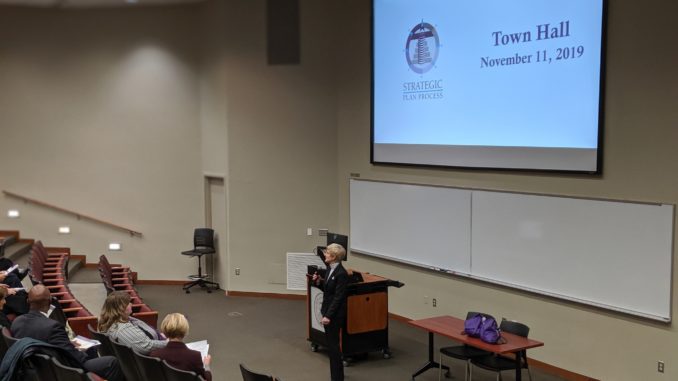
The Truman State University executive leadership team is developing the next University strategic plan which focuses on community input and metrics for goal measurement.
Truman’s current strategic plan was approved by the Board of Governors in October 2016 and is effective through 2020. The next plan will need to be approved by the Board of Governors in June of 2020 and will be effective from July 2020 through 2025. The executive leadership team held a town hall event Nov. 11 to discuss the new strategic plan.
The new plan establishes three areas of focus: institutional effectiveness/organizational excellence, student success and achievement, and external validation/reputation. Each area is broken down into specific categories for improvement, such as enrollment, campus climate, academic performance and employer satisfaction. Each of these areas is further defined by metrics created for data collection and assessment.
“This is going to allow us to measure our progress on each of these metrics,” University President Sue Thomas said in the town hall meeting. “So how we want to look at this is what kind of major comprehensive initiatives can we do to be able to move the needle on each of these metrics.”
Janet Gooch, vice president for academic affairs and provost, said the metrics were developed through the executive leadership team, but a lot of them, such as graduation rates, are required by the state for performance funding. Others are institutional specific, Gooch said, so Truman is interested in employer and alumni satisfaction as well as campus climate.
Gooch said the University hasn’t conducted employer satisfaction and alumni satisfaction surveys since 2012. The alumni survey was revised in 2012, but has not been re-implemented.
“With different people in the President’s position and the provost position we just kind of lost sight of that for a little bit,” Gooch said. “Now we recognize that, ‘Yeah, that’s been on the shelf too long, let’s get back to that.’”
Gooch said measuring the success of the strategic plan with metrics is new to this strategic plan being developed. One of the relative weaknesses of the last plan, Gooch explained, was that some of the goals weren’t very measurable. She said some metrics can be more qualitative than quantitative, which makes the metric groups important for defining what those metrics are.
Gooch pointed to the campus climate section as one area that remains unclear in the strategic plan. She said there are a couple measurements for campus climate across the University, but there needs to be more time spent determining what exactly to look at in this area.
“Some of these metrics we have nailed — we know exactly how we’re going to get the data, we know exactly how we’re going to get the metric,” Gooch said. “On others, we’re not so clear.”
The process behind the creation of the strategic plan can differ depending on the administration, Gooch explained. While they have always allowed for feedback, Gooch said the approach the administration is using this time is to be as inclusive as possible from the start.
“We’re very interested in what the faculty and staff think our priorities should be and where we need to really focus our attention moving forward,” Gooch said.
Gooch said input is important because Truman needs institutional buy-in from the different areas of campus so that everyone feels invested in the plan and carrying it out.
Thomas said the University community should be thinking about how to operate differently to improve the defined metrics. While there are some important initiatives on campus, Thomas said, those might be set aside to focus on what will make the most impact on the metrics.
In addition to the metrics, Thomas said the new strategic plan could include a second Strategic Planning and Assessment Workshop day to keep faculty and staff informed about University data and progress on the strategic plan. She said this second SPAW day would allow the University to stay more focused on the plan.
Gooch said the strategic plan is important because it gives the University the opportunity to think through what it can accomplish and how it will get there in about five years.
Truman has to have a strategic plan for its accreditation with the state, but Gooch said it is also a valuable exercise.
“It really is a form of assessment for an institution — a time to set goals and be visionary and then create a plan, a strategy, so that everybody knows how we’re going to get where we want to be,” Gooch said.
